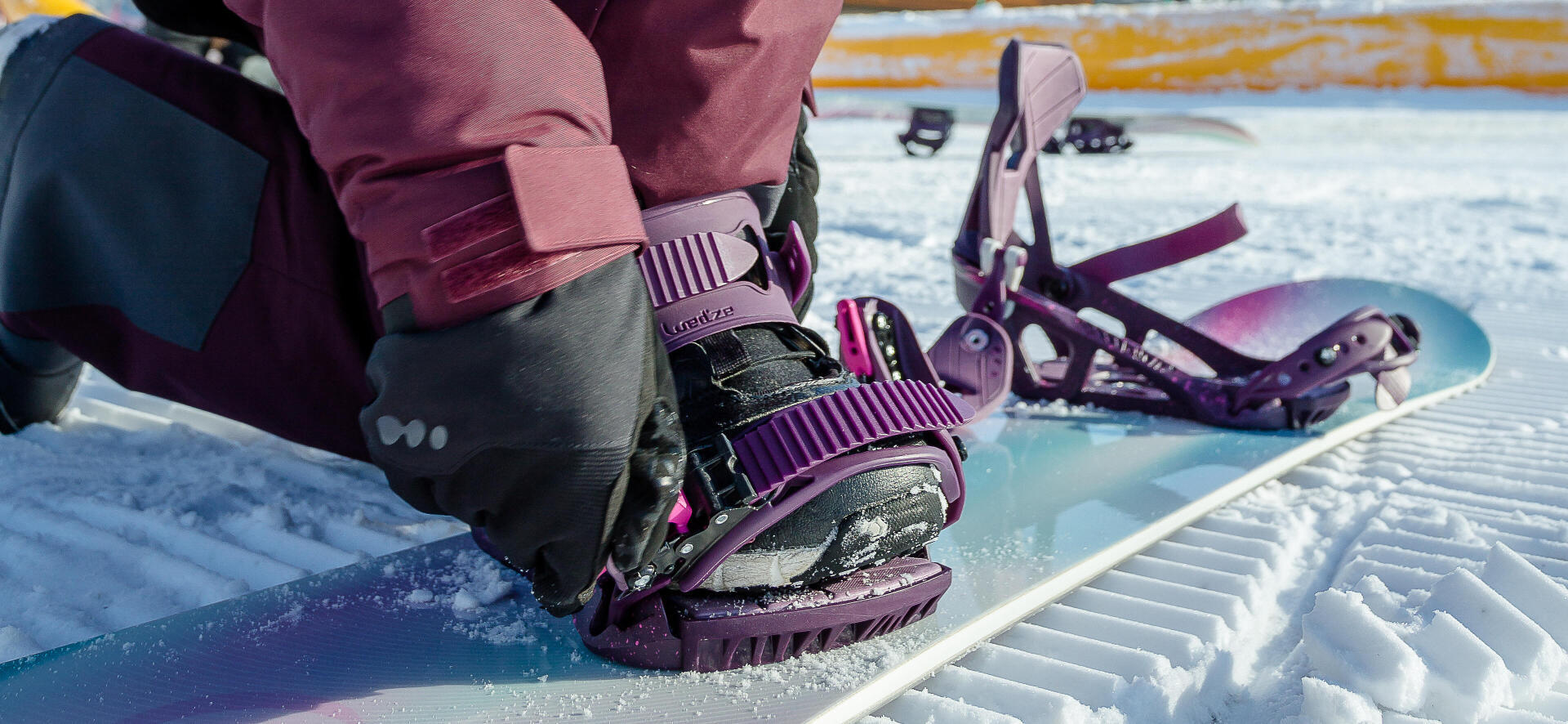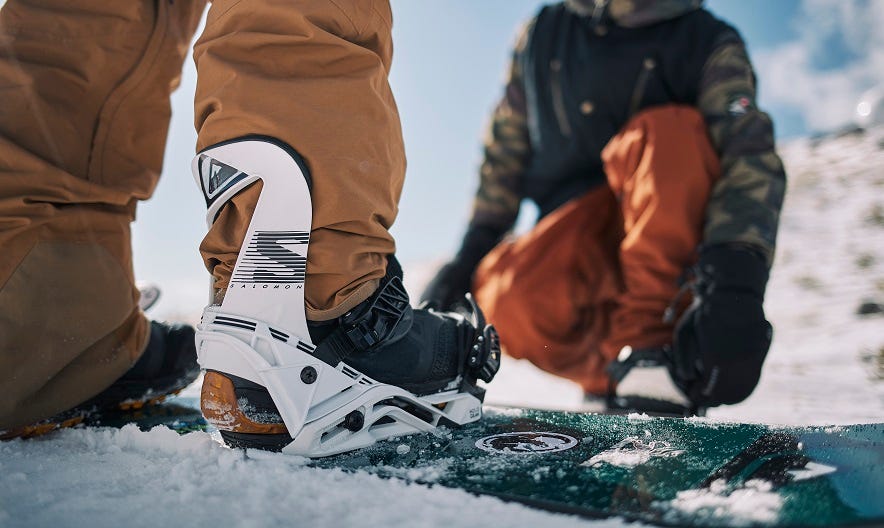
How to Choose the Right Snowboarding Bindings for Your Riding Style and Skill Level
Written: editor | July 28, 2023

Types of Snowboarding Bindings
In the world of snowboarding, choosing the right bindings is crucial to ensure a comfortable and secure ride. With a variety of options available, it can be overwhelming to make a decision. Here are three types of bindings to consider:
1. Traditional Strap Bindings
These are the most common type of bindings and are widely used by snowboarders of all skill levels. They feature two straps that fasten across the foot and ankle, providing a secure fit and excellent control. Strap bindings offer flexibility and adjustability, allowing you to customize the fit to your comfort level. They are versatile and suitable for riding all types of terrain.
2. Rear-Entry Bindings
Rear-entry bindings, also known as speed entry or quick-entry bindings, are designed for convenience and ease of use. They feature a reclining highback that allows you to slide your foot in and out of the binding without the need to adjust the straps every time. Rear-entry bindings are great for riders who value speed and efficiency. They provide a comfortable fit and are ideal for riders who like to spend less time strapping in and more time on the slopes.
3. Step-On Bindings
Step-On bindings are the newest innovation in snowboarding bindings. They use a clip-in system that allows you to quickly and securely attach your boots to the bindings. Step-On bindings eliminate the need for straps or buckles, providing a seamless and hassle-free experience. They are ideal for riders who want maximum convenience and quick entry and exit. However, it's important to note that Step-On bindings may have limited compatibility with certain boot and binding combinations.
When choosing snowboarding bindings, consider your riding style, skill level, and personal preference. It's recommended to try different bindings to find the one that offers the best fit, comfort, and performance for your snowboarding adventures.

Factors to Consider When Choosing Snowboarding Bindings
When it comes to snowboarding, having the right bindings is crucial for performance and comfort. With a wide range of options available, it's important to consider these key factors before making a decision.
1. Flex and Response
The flex and response of your bindings play a significant role in your riding style. Stiffer bindings provide more control and stability at high speeds or on challenging terrain, while softer bindings offer a more playful and forgiving ride. Consider your skill level and preferences to determine the level of flex and response you need.
2. Compatibility with Snowboard Boots
Ensure that the bindings you choose are compatible with your snowboard boots. Bindings and boots come in different sizes and styles, so it's essential to match them correctly. Look for bindings with adjustable straps and bindings that offer compatibility with a variety of boot sizes.
3. Binding Size and Fit
Choosing the right binding size is crucial for comfort and performance. The size of the binding should correspond to your boot size, and it's important to consider the width of your snowboard as well. A proper fit will ensure better control and prevent discomfort or foot fatigue.
4. Adjustability and Ease of Use
Consider the level of adjustability and ease of use offered by the bindings. Look for bindings with multiple strap adjustments, highbacks, and baseplates that can be customized to fit your preferences. Additionally, bindings with quick-release mechanisms or tool-less adjustments can make it easier to fine-tune your setup on the hill.
By considering these factors, you can choose the right snowboarding bindings that will enhance your riding experience and help you reach your full potential on the slopes. Remember to try on different bindings and seek advice from experienced snowboarders to find the perfect fit for you.

Top Snowboarding Binding Brands
1. Burton Bindings
When it comes to choosing the right snowboarding bindings, Burton is one of the most trusted brands in the market. Known for their durable construction and innovative designs, Burton bindings offer a wide range of options for all types of riders. Whether you're a beginner or a seasoned pro, you can trust Burton to provide bindings that offer comfort, performance, and reliability on the slopes.
2. Union Bindings
Another top brand to consider is Union. Union bindings are known for their high-quality materials and superior craftsmanship. They offer a great balance of flexibility, responsiveness, and durability. With a variety of models available, Union bindings cater to different riding styles and preferences. Whether you prefer all-mountain, freestyle, or freeride, Union has a binding that will suit your needs.
3. Ride Bindings
Ride bindings are another popular choice among snowboarders. With a focus on performance and comfort, Ride bindings are designed to enhance your riding experience. They offer features like adjustable straps, cushioned footbeds, and easy-to-use buckles. Ride bindings are known for their versatility and ability to handle various terrain and conditions.
When choosing the right snowboarding bindings, it's important to consider your riding style, preferences, and skill level. Take the time to research different brands, read reviews, and try on different bindings to ensure the best fit and performance. Remember, the right bindings can greatly enhance your snowboarding experience and make all the difference on the slopes. So, don't hesitate to invest in quality bindings that will keep you comfortable and secure as you carve your way down the mountains.

Binding Features and Technologies
1. Highback Design and Adjustability
When choosing snowboarding bindings, consider the highback design and adjustability. The highback is the support structure behind your legs and plays a crucial role in controlling your board. Look for bindings with adjustable highbacks that allow you to customize the forward lean and provide the right amount of support for your riding style.
2. Baseplate Material and Construction
The baseplate is the interface between your boots and the snowboard. It should provide a stable and responsive connection. Look for bindings with a strong and lightweight baseplate material, such as aircraft-grade aluminum or composite materials. Consider the construction of the baseplate as well, as a rigid and well-designed baseplate will transfer your movements efficiently to the board.
3. Strap Systems and Cushioning
Strap systems and cushioning play a significant role in comfort and performance. Look for bindings with reliable and adjustable strap systems that secure your boots tightly. Opt for bindings with cushioning technologies like EVA foam or gel inserts that absorb shocks and vibrations on rough terrain.
4. Ratchets and Buckles
The ratchets and buckles on your bindings are responsible for securing the straps in place. Look for bindings with durable and easy-to-use ratchets and buckles. Quick-release mechanisms can save you time on the mountain, especially when adjusting your bindings.
Remember, everyone has different preferences and riding styles, so take the time to try on and test different bindings before making a decision. Consider your skill level, terrain preferences, and the type of snowboarding you enjoy most. By selecting the right bindings with the features and technologies that suit your needs, you'll enhance your snowboarding experience and maximize your performance on the slopes. Happy riding!

Choosing the Right Bindings for Your Riding Style
When it comes to snowboarding, having the right bindings is crucial for a successful and enjoyable ride. With so many options available, it can be overwhelming to choose the perfect pair. But fear not, we're here to help you make the right decision based on your riding style!
1. Freestyle Bindings
If you love hitting the park and performing tricks, freestyle bindings are the way to go. These bindings are known for their flexibility and maneuverability, allowing you to easily twist and turn. Look for bindings with softer flex and more forgiving features. They often have a shorter baseplate, which provides better control and helps with quick movements.
2. All-Mountain Bindings
If you enjoy a bit of everything and want bindings that can handle any terrain, all-mountain bindings are your best bet. These bindings offer a balanced mix of flexibility and responsiveness. They are designed to perform well in various conditions, from groomed runs to backcountry powder. Look for bindings with medium flex and adjustable features for versatility.
3. Freeride Bindings
For those adrenaline junkies who seek adventure in untouched powder and steep terrain, freeride bindings are the way to go. These bindings are stiffer and more responsive, providing increased power and control. They often have a longer baseplate, which offers better stability and edge-to-edge transfer. Look for bindings with a high level of support and adjustable features for a customized fit.
Remember, it's important to try on different bindings and see which ones feel the most comfortable and secure. Each rider is unique, and what works for someone else might not work for you. By choosing the right bindings for your riding style, you'll be able to maximize your performance and have an unforgettable snowboarding experience. So hop on your board and hit the slopes with confidence!

Frequently Asked Questions (FAQs)
Common questions related to snowboarding bindings and their answers
Are you confused about which snowboarding bindings to choose? Don't worry, we've got you covered! Below are some common questions people have about snowboarding bindings and their answers to help you make the right choice.
1. What type of bindings should I choose?
The type of bindings you should choose depends on your snowboarding style and preference. There are three main types: strap-in bindings, rear-entry bindings, and step-on bindings. Strap-in bindings are the most common and offer great flexibility and adjustability.
2. What should I consider when selecting bindings?
When selecting bindings, consider factors such as your riding style, skill level, boot compatibility, and personal preference. It's important to choose bindings that provide a secure fit, good response, and proper flex for your style of snowboarding.
3. How do I determine the right size of bindings?To determine the right size of bindings, you need to consider both your boot size and board size. Most binding sizes are adjustable and can accommodate a range of boot sizes. It's recommended to refer to the manufacturer's sizing chart for a more accurate fit.
4. Are more expensive bindings better?Not necessarily. While more expensive bindings often come with additional features and higher-quality materials, they may not be suitable for everyone. It's important to choose bindings that match your skill level, riding style, and budget.
5. Can I use any bindings with any snowboard?Bindings are designed to be compatible with specific types of snowboards. Make sure to check the compatibility between your snowboard and bindings before making a purchase. Most bindings are adjustable and can fit a range of board sizes.
Now that you have some answers to commonly asked questions, you can make a more informed decision when choosing the right snowboarding bindings for your next adventure on the slopes. Happy shredding!



